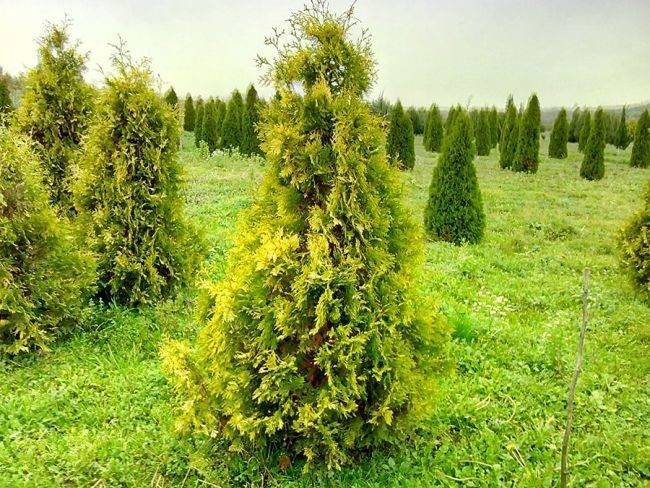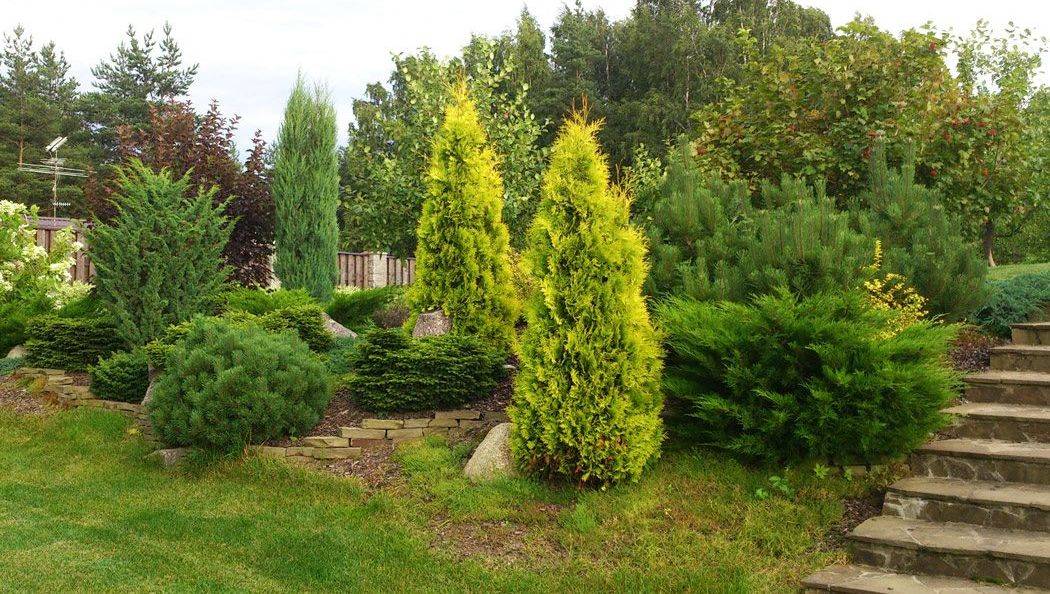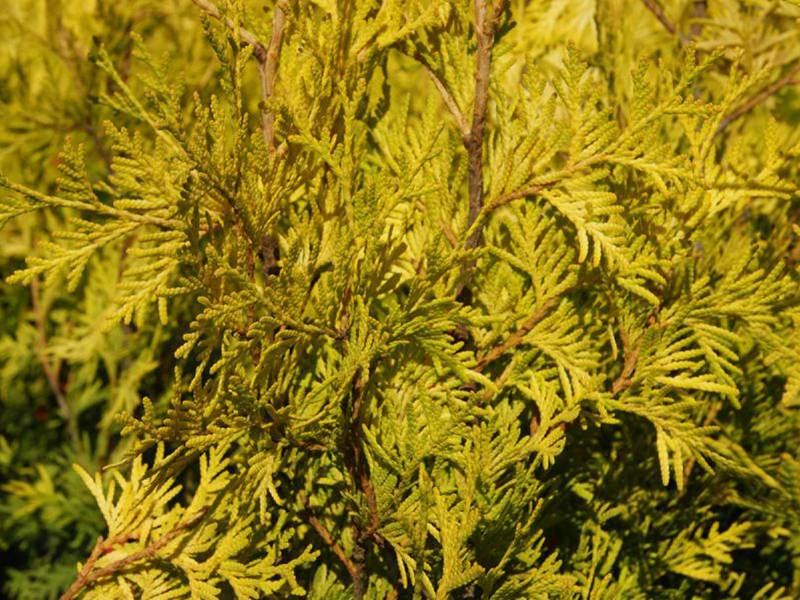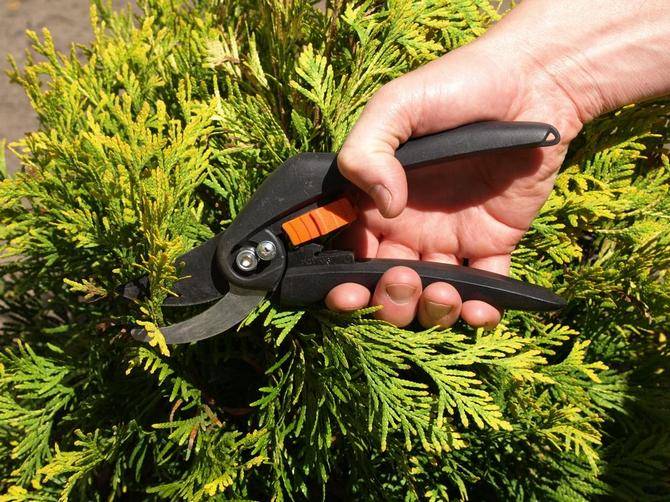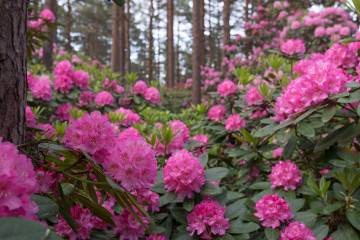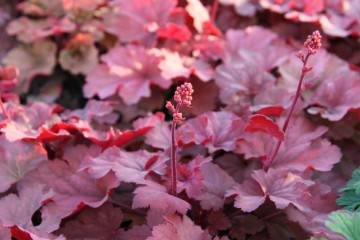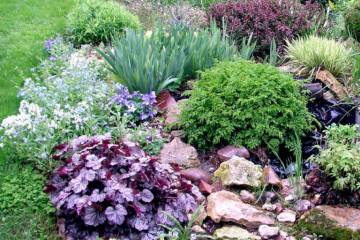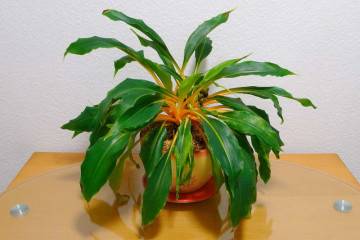Thuja Yellow Ribbon (Yellow Ribbon) western - description
Content:
Thuja western Yellow Ribbon is quite popular among landscape designers and ordinary gardeners. This evergreen plant is easily recognizable by its original pyramidal crown shape. Thuja slightly changes the shade of foliage depending on the season, which adds even more charm to it.
Description of Western Tut Yellow Ribbon
Thuja western Yellow Ribbon is an unusual tree with golden needles. It looks great both in single landings and in group compositions. It looks especially impressive against the background of bright greenery of other trees, acting as a bright sunspot. This thuja is loved not only for its visual appeal, but also for:
- high frost resistance;
- wind resistance;
- resistance to temperature extremes and exposure to sunlight.
Dimensions (edit)
The full botanical name of the plant is Thuja occidentalis yellow ribbon. In its description, the following parameters are distinguished:
- plant height 2.5 m;
- diameter 80 cm;
- the conical shape of the crown is sometimes more like a drop-shaped one with a round base and a pointed apex;
- dense dense branches with a lot of shoots;
- small brown bumps;
- fibrous root system.
How fast is thuja Yellow Ribbon growing
The Yellow Ribbon reaches its maximum height by the age of 15 years. The annual growth is 10-12 cm, the diameter increases by 8-10 cm per year. Despite the fact that this plant is a slow-growing plant, it is quite durable, the average life expectancy is more than 50 years. Throughout this period, thuja does not lose its attractiveness.
Planting and caring for Thuja Yellow Ribbon
Thuja Yellow Ribbon is often used to create hedges. It looks great at any time of the year, standing out both against the background of bright greenery and among the dazzling whiteness of the snow. In order for the thuja to grow correctly, you need to pay attention to some of the features of its planting.
How to plant
To plant the Yellow Ribbon correctly, you should follow a simple instruction:
- The plant is planted in a pre-prepared planting pit, the size of which is 1.5 times the earthen lump in which the thuja grows. A mixture of fertile soil and a small amount of manure or compost is laid at the bottom of the pit.
- The seedling is immersed in the center of the hole, the roots are gently straightened, the root collar is located slightly above the soil level.
- The remaining gaps are covered with fertile soil with an admixture of peat and the addition of nitroammofoska (500 g in one pit).
- The soil around the seedling is compacted and watered abundantly.
- The trunk circle is mulched with peat, sawdust or compost.
Watering mode
Watering is one of the mandatory procedures for the care of Yellow Ribbon. It is especially important in hot weather. At this time, you need to water the tree 3 times a week, 10 liters per plant. If summer is not dry, weekly watering is sufficient.Tue really likes the sprinkling procedure, it refreshes the greenery of the plant and speeds up the process of producing phytoncides that purify the air. After watering, the land around you needs to loosen up.
Top dressing
If the Yellow Ribbon is planted correctly, then the first 2 years of feeding will not be needed, because all the necessary nutrients have already been introduced into the planting pit. Then thuyas require annual application of potash and phosphorus fertilizers, but nitrogen fertilizers should be excluded completely, since they will further slow down the growth of the plant. If there is a need for them, then they are introduced only in early spring. As far as organic matter is concerned, fresh manure cannot be used. This is especially true for concentrated chicken manure.
Features of summer care
It is not difficult to take care of thuja in the summer, but regular care is required, without it the foliage will dry out, the number of cones will increase, which will negatively affect the appearance of the plant.
Summer care features:
- timely weeding;
- maintaining the cleanliness of the trunk circle;
- regular watering of the tree;
- moderate feeding;
- annual spring pruning.
Preparing for winter
This variety of thuja is characterized by high frost resistance, it is able to withstand temperatures down to -35 ° C. But, like other thermophilic plants, some preparation for the winter period is required. Before the onset of cold weather, the trunk circle is mulched with a layer of peat at least 10 cm high.
Reproduction of thuja Yellow Ribbon
Most often, ready-made thuja seedlings are purchased in special nurseries, this simplifies the planting procedure and helps the plant adapt faster in a new place. But for those who want to propagate a tree on their own, there is an alternative to ready-made seedlings. Like other varieties of thuja, Yellow Ribbon propagates by seed and cuttings.
Seed propagation will require self-harvested seeds. The cones are dried, their scales open, and the seeds are carefully removed from there. They are stored in fabric bags in a cool place throughout the winter. Sowing in open ground occurs only in the spring after the snow melts. The seeds are placed in the soil to a depth of 30-35 cm. After that, the surface of the soil is sprinkled with a small layer of sawdust (preferably coniferous). Seedlings need regular thorough watering with settled water.
Propagation by cuttings
The most popular way to propagate the Yellow Ribbon thuja is by cuttings. At the end of autumn, before the onset of the first frost, twigs about 15 cm long are cut with sharp scissors. For a day, they are placed in a glass of water with a solution of a growth accelerator, after which they are planted in boxes (or pots) with prepared soil mixture. It should be sufficiently loose and nutritious. Planting directly into open ground is possible, but this option is more suitable for regions with mild winters.
After planting, the cuttings are covered with cut bottles or foil. Periodically, the shelter is raised to ventilate and water the soil. It should always be moist.
Why does thuja Yellow Ribbon turn yellow
Thuja yellowing can be triggered by a number of reasons. And if it is easy to eliminate errors in care, then it is much more difficult to cope with some diseases. So, the main factors that can cause yellowing of the crown of Thuja Yellow Ribbon:
- dust settling on the leaves. This is especially true for plants that are located along city roads. Sprinkling can save from this;
- insufficient watering provokes not only yellowing, but also drying of thuja branches;
- similar symptoms arise due to various pests attacking the thuja; special insecticides will help to combat them.
Thuya Ellow Ribbon is a decoration of any garden, park, suburban area. It is regularly used in landscape design, it is used for landscaping urban areas. Thanks to its unusual colors, the Yellow Ribbon always attracts the eye and stands out from the general background. The soft golden color is perfect for those who want to create a cozy atmosphere not only in the house, but also in the backyard area.
